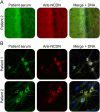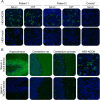Neurochondrin is a neuronal target antigen in autoimmune cerebellar degeneration
- PMID: 27957508
- PMCID: PMC5141526
- DOI: 10.1212/NXI.0000000000000307
Neurochondrin is a neuronal target antigen in autoimmune cerebellar degeneration
Abstract
Objective: To report on a novel neuronal target antigen in 3 patients with autoimmune cerebellar degeneration.
Methods: Three patients with subacute to chronic cerebellar ataxia and controls underwent detailed clinical and neuropsychological assessment together with quantitative high-resolution structural MRI. Sera and CSF were subjected to comprehensive autoantibody screening by indirect immunofluorescence assay (IFA) and immunoblot. Immunoprecipitation with lysates of hippocampus and cerebellum combined with mass spectrometric analysis was used to identify the autoantigen, which was verified by recombinant expression in HEK293 cells and use in several immunoassays. Multiparameter flow cytometry was performed on peripheral blood and CSF, and peripheral blood was subjected to T-cell receptor spectratyping.
Results: Patients presented with a subacute to chronic cerebellar and brainstem syndrome. MRI was consistent with cortical and cerebellar gray matter atrophy associated with subsequent neuroaxonal degeneration. IFA screening revealed strong immunoglobulin G1 reactivity in sera and CSF with hippocampal and cerebellar molecular and granular layers, but not with a panel of 30 recombinantly expressed established neural autoantigens. Neurochondrin was subsequently identified as the target antigen, verified by IFA and immunoblot with HEK293 cells expressing human neurochondrin as well as the ability of recombinant neurochondrin to neutralize the autoantibodies' tissue reaction. Immune phenotyping revealed intrathecal accumulation and activation of B and T cells during the acute but not chronic phase of the disease. T-cell receptor spectratyping suggested an antigen-specific T-cell response accompanying the formation of antineurochondrin autoantibodies. No such neurochondrin reactivity was found in control cohorts of various neural autoantibody-associated neurologic syndromes, relapsing-remitting multiple sclerosis, cerebellar type of multiple system atrophy, hereditary cerebellar ataxias, other neurologic disorders, or healthy donors.
Conclusion: Neurochondrin is a neuronal target antigen in autoimmune cerebellar degeneration.
Figures




References
-
- Melzer N, Meuth SG, Wiendl H. Neuron-directed autoimmunity in the central nervous system: entities, mechanisms, diagnostic clues, and therapeutic options. Curr Opin Neurol 2012;25:341–348. - PubMed
LinkOut - more resources
Full Text Sources
Other Literature Sources
